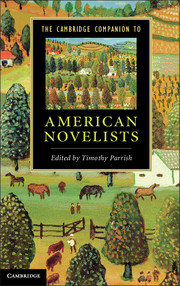Book contents
- Frontmatter
- Contents
- Contributors
- Introduction
- 1 James Fenimore Cooper
- 2 Nathaniel Hawthorne
- 3 Herman Melville
- 4 Harriet Beecher Stowe
- 5 Mark Twain
- 6 Henry James
- 7 Edith Wharton
- 8 Theodore Dreiser
- 9 Willa Cather
- 10 F. Scott Fitzgerald
- 11 Ernest Hemingway
- 12 William Faulkner
- 13 Henry Roth
- 14 Djuna Barnes
- 15 Zora Neale Hurston
- 16 Richard Wright
- 17 Raymond Chandler
- 18 Ralph Ellison
- 19 J. D. Salinger
- 20 Patricia Highsmith
- 21 Vladimir Nabokov
- 22 Jack Kerouac
- 23 Saul Bellow
- 24 Kurt Vonnegut
- 25 John Updike
- 26 Thomas Pynchon
- 27 Toni Morrison
- 28 Philip Roth
- 29 Don DeLillo
- 30 Cormac McCarthy
- Guide to Further Reading
- Index
- References
Introduction
Published online by Cambridge University Press: 05 December 2012
- Frontmatter
- Contents
- Contributors
- Introduction
- 1 James Fenimore Cooper
- 2 Nathaniel Hawthorne
- 3 Herman Melville
- 4 Harriet Beecher Stowe
- 5 Mark Twain
- 6 Henry James
- 7 Edith Wharton
- 8 Theodore Dreiser
- 9 Willa Cather
- 10 F. Scott Fitzgerald
- 11 Ernest Hemingway
- 12 William Faulkner
- 13 Henry Roth
- 14 Djuna Barnes
- 15 Zora Neale Hurston
- 16 Richard Wright
- 17 Raymond Chandler
- 18 Ralph Ellison
- 19 J. D. Salinger
- 20 Patricia Highsmith
- 21 Vladimir Nabokov
- 22 Jack Kerouac
- 23 Saul Bellow
- 24 Kurt Vonnegut
- 25 John Updike
- 26 Thomas Pynchon
- 27 Toni Morrison
- 28 Philip Roth
- 29 Don DeLillo
- 30 Cormac McCarthy
- Guide to Further Reading
- Index
- References
Summary
The novel existed before the United States of America, but American history has been peculiarly conducive to the novel’s formal possibilities. When Miguel de Cervantes wrote arguably the first novel, the globe was still terra incognita. The story of Don Quixote (1605, 1615) was largely the story of antiquated assumptions about culture, history, and identity being subjected to and in a sense destroyed by new ways of perceiving, knowing, and imagining that ever since that period have persistently been called “modern.” Even as the form of the novel spread throughout Europe and on to America and elsewhere, its persistent preoccupation has been the question of individual identity. The novel has charted the relationship between an individual consciousness and the world around it. To Cervantes, Quixote’s quest to assert the will of his self, though, was unsettling and fundamentally comic. Previous heroes such as Achilles, Odysseus, or Aeneas fulfilled their destiny; they did not create it. The prospect that an individual could fashion himself as a protagonist, a hero, without the consent or even the interest of the gods and despite the prevailing wisdom of social institutions such as the church was the beginning of a new conception of identity. “In the absence of a Supreme Judge,” Milan Kundera suggests, the world of Don Quixote “suddenly appeared in its fearsome ambiguity” as the “single divine Truth decomposed into myriad relative truths parceled out by men. Thus was born the world of the Modern Era, and with it the novel, the image of and model of that world” (6).
- Type
- Chapter
- Information
- The Cambridge Companion to American Novelists , pp. xvii - xxxivPublisher: Cambridge University PressPrint publication year: 2012



